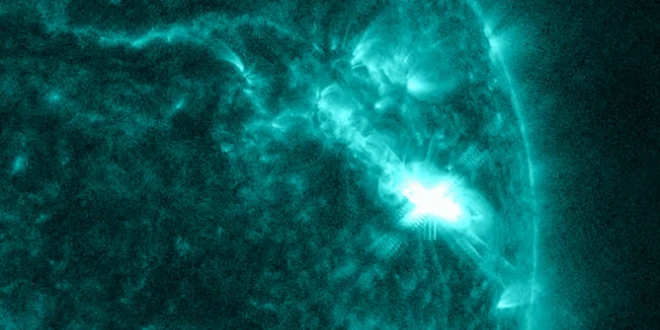On New Year’s Eve, a significant solar flare erupted from the Sun’s surface, leading to warnings for high-frequency radio users from space monitoring agencies. The Space Weather Prediction Center (SWPC) of the National Oceanic and Atmospheric Administration (NOAA) published an image of this flare on Sunday (Dec 31), appearing as a bright spot on the Sun.
The SWPC explained that a solar flare is a burst of energy from the Sun, typically lasting from a few minutes to several hours. The flare observed on Sunday was classified as an X5 flare.
Solar flares are categorized by NASA based on their intensity, similar to the classification of earthquakes. This system includes B-class, C-class, M-class, and X-class flares, with each class representing a tenfold increase in energy output.
X-class flares, particularly those above 9, can have significant effects, such as triggering radiation storms that disrupt satellites and cause global transmission issues. The most intense X-class flare on record was an X45 in 2003.
Flares in the B and C classes are generally too weak to affect Earth, while M-class flares can cause radio blackouts at the poles and minor radiation storms.
The recent X5 flare, though not as strong as the 2003 event, was the most intense since September 2017. It had the potential to impact high-frequency radio signals, leading to degradation or loss of communication on Earth’s sunlit side.
The SWPC advised that while the general public need not worry, emergency managers might experience communication disruptions. They also noted that the likelihood of seeing auroras resulting from Sunday’s flare was low.
A minor geomagnetic storm was forecasted by the SWPC for Tuesday night (Jan 2), but the chances of observing an aurora were considered minimal.
As the Sun progresses through Solar Cycle 25, an increase in solar activity and Coronal Mass Ejections (CMEs) is anticipated throughout 2024. NOAA states that solar cycles, which last about 11 years, involve the Sun flipping its magnetic poles, leading to space weather events like flares and CMEs. These phenomena can send plasma and magnetic material from the Sun towards Earth in as little as 15 to 18 hours.


